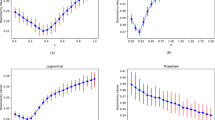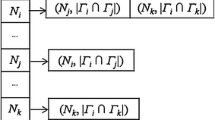Abstract
Computing Profile Similarity is a fundamental requirement in the area of Social Networks to suggest similar social connections that have high chance of being accepted as actual connection. Representing and measuring similarity appropriately is a pursuit of many researchers. Cosine similarity is a widely used metric that is simple and effective. This paper provides analysis of cosine similarity for social profiles and proposes a novel method to compute Piecewise Maximal Similarity between profiles. The proposed metric is 6% more effective to measure similarity than cosine similarity based on computations on real data.


Similar content being viewed by others
References
Anderson, A., Huttenlocher, D., Kleinberg, J., & Leskovec, J. (2012). Effects of user similarity in social media. doi:10.1145/2124295.2124378.
Aneja, N., & Gambhir, S. (2012). Various issues in ad-hoc social networks. In: Proceedings of National Conference on Recent Trends in Computer Scince and Information Technology (RTCSIT) (pp. 6–9). Echelon Institute of Technology, Faridabad, Haryana, India. http://echeloninstitute.org/images/download/proceedingRTCSIT.pdf.
Aneja, N., & Gambhir, S. (2014). Geo-social profile matching algorithm for dynamic interests in ad-hoc social network. Social Networking, 3(5), 240–247. doi:10.4236/sn.2014.35029. http://www.scirp.org/journal/PaperDownload.aspx?paperID=51108.
Aneja, N., & Gambhir, S. (2015). Geo-social semantic profile matching algorithm for dynamic interests in ad-hoc social network. In: 2015 IEEE International Conference on Computational Intelligence and Communication Technology (CICT). IEEE.
Caputo, A., Socievole, A., & Rango, F. D. (2015). CRAWDAD dataset unical/socialblueconn (v. 2015-02-08). Downloaded from http://crawdad.org/unical/socialblueconn/20150208 doi:10.15783/C7GK5R.
Chigozie, O., Williams, P., & Osegi, N. E. (2015). Hybrid social networking application for a university community. CoRR abs/1503.05642. http://arxiv.org/abs/1503.05642.
Chung, E., Joy, J., & Gerla, M. (2015). Discoverfriends: Secure social network communication in mobile ad hoc networks. CoRR abs/1505.07487. http://arxiv.org/abs/1505.07487.
Facebook. (2004). Facebook. https://www.facebook.com/.
Gambhir, S., & Aneja, N. (2013). Ad-hoc social network: A comprehensive survey. International Journal of Scientific and Engineering Research, 4(8), 156–160. http://www.ijser.org/researchpaper%5CAd-hoc-Social-Network-A-Comprehensive-Survey.pdf.
Gambhir, S., Aneja, N., & Mangla, S. (2015). Need of ad-hoc social network based on users dynamic interests. In: IEEE 2015 International Conference on Soft Computing Techniques and Implementation (ICSCTI). IEEE.
Google. (2011). Google+. https://plus.google.com/.
Han, X., Wang, L., Crespi, N., Park, S., & Cuevas, A. (2015). Alike people, alike interests? Inferring interest similarity in online social networks. Decision Support Systems, 69(C), 92–106. doi:10.1016/j.dss.2014.11.008.
Kraus, N., Carmel, D., Keidar, I., & Orenbach, M. (2015). NearBucket-LSH: Efficient similarity search in P2P networks. http://arxiv.org/abs/1511.07148.
Lee, J., & Hong, C. S. (2011). A mechanism for building ad-hoc social network based on user’s interest. doi:10.1109/APNOMS.2011.6076997.
LinkedIn. (2002). LinkedIn. https://www.linkedin.com/.
Mangla, S., & Gambhir, S. (2015). Research challenges in ad-hoc social network (ASN). International Journal of Advance Research in Science and Engineering, 4(1), 124–128. http://www.ijarse.com/images/fullpdf/159a.pdf.
Mizzaro, S., Pavan, M., & Scagnetto, I. (2015). Content based similarity of twitter users. Lecture Notes in Computer Science, Advances in Information Retrieval, Vol. 9022.
Socievole, A., De Rango, F., & Caputo, A. (2014). Wireless contacts, facebook friendships and interests: Analysis of a multi-layer social network in an academic environment. In: Wireless Days (WD), 2014 IFIP, pp. 1–7. doi:10.1109/WD.2014.7020819.
Spertus, E., Sahami, M., & Buyukkokten, O. (2005). Evaluating similarity measures: A large-scale study in the orkut social network. In: Proceedings of the Eleventh ACM SIGKDD International Conference on Knowledge Discovery in Data Mining, KDD ’05 (pp. 678–684). ACM, New York, NY, USA. doi:10.1145/1081870.1081956. http://doi.acm.org/10.1145/1081870.1081956.
Twitter. (2006). Twitter. https://twitter.com/.
Zhang, D., Zhang, D., Xiong, H., Hsu, C. H., & Vasilakos, A. (2014). Basa: Building mobile ad-hoc social networks on top of android. IEEE Network, 28(1), 4–9. doi:10.1109/MNET.2014.6724100.
Zhang, Y., Tang, J., Yang, Z., Pei, J., & Yu, P. S. (2015). Cosnet: Connecting heterogeneous social networks with local and global consistency. doi:10.1145/2783258.2783268. http://doi.acm.org/10.1145/2783258.2783268.
Author information
Authors and Affiliations
Corresponding author
Rights and permissions
About this article
Cite this article
Gambhir, S., Aneja, N. & De Silva, L.C. Piecewise Maximal Similarity for Ad-hoc Social Networks. Wireless Pers Commun 97, 3519–3529 (2017). https://doi.org/10.1007/s11277-017-4683-4
Published:
Issue Date:
DOI: https://doi.org/10.1007/s11277-017-4683-4




